A table saw, often considered the heart of any woodworking shop, is an essential tool for both professional carpenters and DIY enthusiasts. It is a versatile piece of equipment that can perform a variety of tasks, from making precise cuts to shaping wood. This tool consists of a circular saw blade, mounted on an arbor, that protrudes through the surface of a table, providing support for the material being cut.
Table saws come in various sizes and types, each designed to suit different woodworking needs. They are known for their power, precision, and ability to make clean, straight cuts. Whether you are building furniture, crafting cabinets, or creating intricate woodwork designs, a table saw can make the job easier and more efficient.
However, buying a table saw is not a decision to be taken lightly. It requires a thorough understanding of the tool, its features, and its uses. This article aims to provide a comprehensive guide to table saws, helping you make an informed decision when purchasing one.
Our Top Table Saw Picks
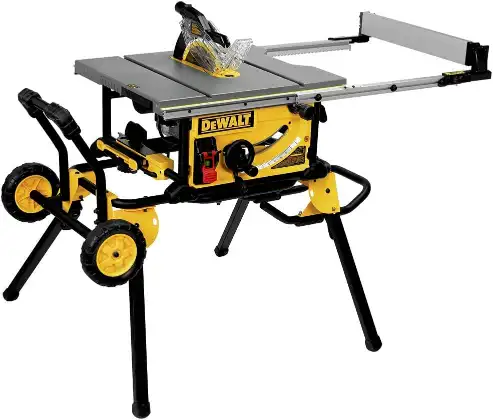
DEWALT 10-Inch Table Saw with Rolling Stand
Check on AmazonKey Specs:
- Motor: 15-amp for fast cutting
- Rip Capacity: 32-1/2 inches
- Depth of Cut: 3-1/8″ at 90°, 2-1/4″ at 45°
- Dust Collection Port: 2-1/2″ for efficient vacuum hookup
- Stand: Rolling, designed for easy transport and stability
DEWALT 10-Inch Table Saw with Rolling Stand offers exceptional performance for woodworkers, combining powerful features and portability. The rack & pinion telescoping fence system allows for quick, accurate adjustments, while the 15-amp motor powers through hardwoods. The rolling stand makes setup and breakdown easy, and the dust collection port ensures a cleaner workspace. With a 32-1/2″ rip capacity, it handles larger materials with ease.
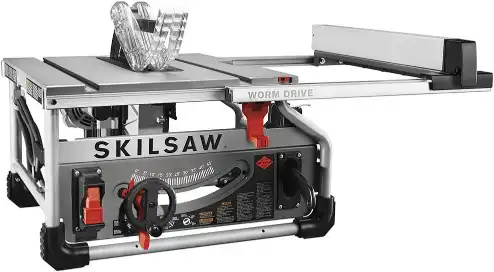
SKILSAW SPT70WT-01 10″ Portable Worm Drive Table Saw
Check on AmazonKey Specs:
- Motor: 15 Amp Dual-Field for increased cutting speed
- Rip Capacity: 25 inches
- Depth of Cut: 3-1/2 inches
- Blade: 10-inch carbide-tipped blade with 24 teeth
- Weight: 49 pounds for portability
SKILSAW SPT70WT-01 10″ Portable Worm Drive Table Saw is designed for power and precision. The brass-geared worm drive provides maximum torque, while the 15-amp Dual-Field motor ensures faster cuts and longer motor life. With a 25-inch rip capacity and 3-1/2-inch depth of cut, it handles a variety of materials. Its self-aligning rip fence ensures accurate cuts, and the compact design makes it portable and easy to transport at just 49 pounds.
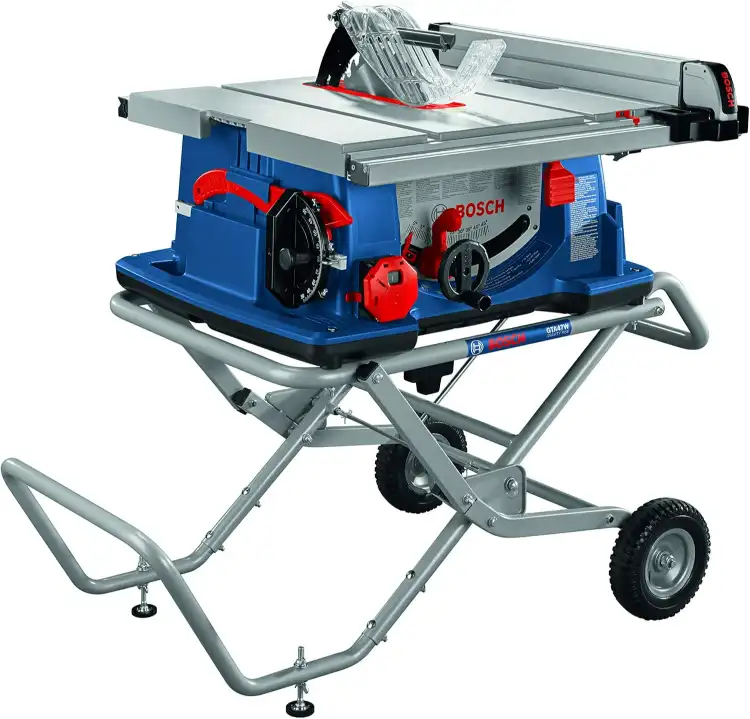
BOSCH 4100XC-10 10 In. Worksite Table Saw
Check on AmazonKey Specs:
- Motor: 15-Amp with 4.0 max HP
- Rip Capacity: 30 inches
- Speed: 3,650 rpm
- Stand: Included GTA47W Gravity-Rise wheeled stand
- Weight: Portable, with easy setup and take down
BOSCH 4100XC-10 10 In. Worksite Table Saw delivers powerful cutting performance with a 15-amp motor and 4.0 max HP, spinning at 3,650 rpm for both fine and rough cuts. The 30-inch rip capacity provides ample workspace, while the soft-start circuitry ensures smooth startup. Its constant response circuitry maintains speed under load. Restart protection minimizes accidental startups. This table saw also features a SquareLock rip fence and Smart Guard System for enhanced safety and precision, and it includes the GTA47W Gravity-Rise wheeled stand for easy portability.
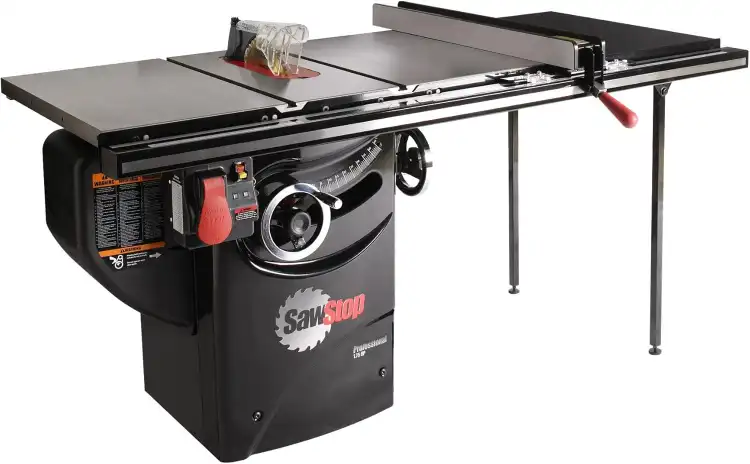
SAWSTOP 10-Inch Professional Cabinet Saw
Check on AmazonKey Specs:
- Motor: 1.75 horsepower
- Fence: 36-inch T-Glide Fence & Rail
- Safety: SawStop patented safety system
- Dust Collection: 99% above and below table (additional accessories sold separately)
- Table Flatness: Maximum gap of 0.010″
The SAWSTOP 10-Inch Professional Cabinet Saw is a high-quality, durable table saw designed for precision and safety. Featuring the 36-inch T-Glide fence assembly, it ensures secure, deflection-free cutting. The SawStop patented safety system provides unparalleled protection by stopping the blade within 5 milliseconds on contact with skin, reducing injury risk to a mere scratch. With exceptional dust collection capabilities and a reliable trunnion and arbor system, this saw delivers top performance for professional woodworkers.
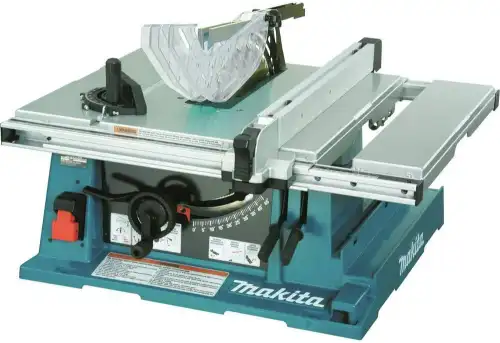
Makita 2705 10-Inch Contractor Table Saw
Check on AmazonKey Specs:
- Motor: 15.0 AMP delivering 4,800 RPM
- Blade: Carbide material
- Safety Features: Tool-less blade guard and anti-kickback pawls
- Adjustment: Adjustable dual side guards for accurate measurements
- Special Feature: Brake for added safety
The Makita 2705 10-Inch Contractor Table Saw offers impressive cutting performance with its 15.0 AMP motor delivering up to 4,800 RPM. Featuring a tool-less modular blade guard system, the adjustable riving knife/spreader enhances safety while allowing for quick installation or removal. The dual side guards ensure easy measurements, and the anti-kickback pawls offer additional protection. Perfect for woodworking professionals, this saw delivers powerful and precise cuts with ease.
Understanding the Importance of a Table Saw in Woodworking
Table saws are indispensable in woodworking due to their versatility and precision. They are capable of making a variety of cuts, including crosscuts, rip cuts, and bevel cuts, making them a go-to tool for many woodworking projects. Their power and speed also allow for efficient work, saving time and effort.
Moreover, table saws offer unparalleled accuracy. The fence and miter gauge ensure that every cut is straight and precise, which is crucial in woodworking where even a slight deviation can ruin a project. With a table saw, you can make repeated cuts with the same measurements, ensuring consistency in your work.
Lastly, table saws are designed for heavy-duty work. They can handle large pieces of wood and make long cuts, which would be challenging with other types of saws. This makes them a valuable tool for large projects and professional woodworking shops.
Types of Table Saws: A Brief Overview
Table saws come in several types, each designed for specific tasks and work environments. The most common types are portable table saws, contractor table saws, hybrid table saws, and cabinet table saws. Portable table saws are lightweight and compact, making them ideal for job sites and small workshops. They are designed for mobility but may lack the power and precision of larger models.
Contractor table saws, on the other hand, are larger and more powerful. They are designed for serious DIYers and professional carpenters who need a reliable tool for heavy-duty work. Hybrid table saws are a blend of contractor and cabinet saws, offering a balance of power, precision, and portability. They are suitable for both professional and home use.
Cabinet table saws are the largest and most powerful type. They are built for professional use and can handle heavy, continuous work. They offer the highest level of precision and durability but are also the most expensive. Understanding these types can help you choose the right table saw for your needs.
Key Features to Look for in a Table Saw
When buying a table saw, several key features should be considered. The first is the power of the motor. A powerful motor can cut through dense wood and make long cuts more efficiently. However, it also consumes more electricity and may require a dedicated circuit. Therefore, you need to balance power with your specific needs and resources.
The second feature is the size and quality of the blade. The blade determines the type of cuts you can make and the thickness of the material you can handle. Look for a blade that is sharp, durable, and suitable for your projects. The size of the table is also important. A larger table provides more support for the material, making it easier to make long and wide cuts.
Other features to consider include the fence and miter gauge, which ensure accuracy and precision, the dust collection system, which keeps your workspace clean, and the safety features, which protect you from accidents. Each of these features contributes to the performance and usability of the table saw.
Understanding the Power and Performance of Table Saws
The power of a table saw is determined by its motor. Most table saws use either a direct-drive motor or a belt-drive motor. Direct-drive motors are connected directly to the blade and transfer all their power to it. They are usually found in portable table saws and are suitable for light to medium-duty work. Belt-drive motors, on the other hand, use a belt and pulley system to transfer power from the motor to the blade. They are more powerful and can handle heavy-duty work, but they also require more maintenance.
Performance, however, is not just about power. It also involves the speed of the blade, the accuracy of the cuts, and the smoothness of operation. A high-quality table saw should have a fast blade speed, allowing for clean and efficient cuts. It should also have a reliable fence and miter gauge for accurate measurements and cuts. Moreover, it should operate smoothly, with minimal vibration and noise.
Lastly, the performance of a table saw is affected by its durability. A durable table saw can withstand heavy use and last for many years. Look for a table saw with a sturdy construction, a robust motor, and high-quality components.
Importance of Blade Size and Material in Table Saws
The blade is one of the most critical components of a table saw. It determines the type of cuts you can make and the thickness of the material you can handle. The size of the blade is measured by its diameter. Most table saws use a 10-inch blade, but larger models may use a 12-inch blade. A larger blade can make deeper cuts, but it also requires more power.
The material of the blade is also important. Most table saw blades are made of steel or carbide. Steel blades are cheaper and can cut through most types of wood, but they tend to dull quickly. Carbide blades are more expensive but are also more durable and stay sharp longer. They can cut through harder materials and provide cleaner cuts.
Lastly, the number of teeth on the blade affects the quality of the cut. A blade with more teeth makes a cleaner cut but cuts slower, while a blade with fewer teeth cuts faster but leaves a rougher edge. Therefore, you need to choose a blade based on the type of cut you want to make and the material you are working with.
The Role of Rip Capacity in Choosing a Table Saw
Rip capacity is another crucial factor to consider when choosing a table saw. It refers to the maximum width of material that the saw can cut in a single pass. A larger rip capacity allows you to cut wider pieces of wood, making the table saw more versatile. However, it also requires a larger table and more space in your workshop.
The rip capacity is determined by the distance between the blade and the fence. Most table saws have an adjustable fence that can be moved to increase or decrease the rip capacity. Some models also have an extendable table that can provide additional support for large pieces of wood.
When choosing a table saw, consider the size of the material you usually work with. If you often cut large pieces of wood, look for a table saw with a large rip capacity. However, if you mostly work with small pieces, a smaller rip capacity may be sufficient.
Safety Features to Consider in a Table Saw
Safety is paramount when using a table saw. These powerful tools can be dangerous if not used properly. Therefore, it’s essential to look for a table saw with robust safety features. One of the most important is the blade guard. This is a cover that protects you from the spinning blade and prevents accidental contact. Some models have a clear blade guard that allows you to see the blade while it’s cutting.
Another crucial safety feature is the riving knife. This is a piece of metal that sits behind the blade and prevents the material from pinching the blade and causing kickback. Kickback is a dangerous situation where the material is thrown back towards the operator at high speed. A riving knife can significantly reduce the risk of kickback.
Other safety features to consider include anti-kickback pawls, which prevent the material from moving backward, a push stick, which keeps your hands away from the blade, and a power switch that is easy to reach in case of emergencies. Some high-end models also have advanced features like flesh-sensing technology, which stops the blade instantly if it comes into contact with skin.
The Significance of Dust Collection in Table Saws
Dust collection is an often-overlooked feature in table saws, but it plays a significant role in maintaining a clean and safe workspace. Cutting wood produces a lot of dust, which can be harmful if inhaled and can make your workspace messy. A good dust collection system can effectively remove dust and keep your workspace clean.
Most table saws have a dust port where you can attach a vacuum or a dust collection bag. Some models also have a blade shroud that directs the dust towards the dust port, making the system more efficient. However, not all dust collection systems are created equal. Some are more effective than others, so it’s worth checking reviews and testing the system if possible.
Moreover, a good dust collection system can prolong the life of your table saw. Dust can accumulate in the motor and other components, causing them to overheat and wear out faster. By removing dust, the system helps keep the table saw in good condition and ensures its longevity.
Assessing the Build Quality and Durability of Table Saws
Build quality and durability are critical factors to consider when buying a table saw. A well-built table saw can withstand heavy use and last for many years, providing good value for your money. On the other hand, a poorly built table saw may break down frequently and require costly repairs or replacements.
The build quality of a table saw is determined by its construction and components. Look for a table saw with a sturdy frame, a robust motor, and high-quality components. The table should be flat and stable, and the fence and miter gauge should be accurate and reliable. The blade should be sharp and durable, and the safety features should be robust and reliable.
Moreover, consider the reputation of the brand and the reviews of other users. Brands with a good reputation often produce high-quality products and provide good customer service. User reviews can provide valuable insights into the durability and performance of the table saw in real-world conditions.
The Impact of Brand Reputation in Choosing a Table Saw
Brand reputation can significantly impact your decision when buying a table saw. Brands with a good reputation often produce high-quality products, provide good customer service, and offer reliable warranties. They have a proven track record and are trusted by many users, giving you confidence in your purchase.
However, brand reputation should not be the only factor to consider. It’s also important to look at the specific features and performance of the table saw. Even the best brands can produce subpar models, and lesser-known brands can produce excellent ones. Therefore, it’s essential to do your research and consider all factors before making a decision.
Moreover, consider your specific needs and budget. A high-end table saw from a reputable brand may have all the features you need and more, but it may also be out of your budget. On the other hand, a budget table saw from a lesser-known brand may lack some features but may be sufficient for your needs and more affordable.
Decoding the Price: How Much Should You Pay for a Table Saw?
The price of a table saw can vary widely, from a few hundred dollars for a basic model to several thousand dollars for a high-end model. The price is determined by several factors, including the type of table saw, the power of the motor, the size and quality of the blade, the build quality, the brand, and the features.
When deciding how much to pay for a table saw, consider your needs and budget. If you are a professional carpenter or a serious DIYer who needs a powerful and versatile tool, it may be worth investing in a high-end table saw. However, if you are a hobbyist or a beginner who only needs a table saw for occasional use, a basic model may be sufficient.
Remember, the most expensive table saw is not necessarily the best one for you. It’s more important to choose a table saw that fits your needs and budget. Moreover, consider the total cost of ownership, including the cost of blades, accessories, maintenance, and electricity.
Where to Buy: Online vs. Offline Purchases of Table Saws
Table saws can be purchased both online and offline, and each option has its advantages. Buying online is convenient and allows you to compare prices and reviews from different sellers. You can also access a wider range of models, including those from international brands. However, you can’t physically inspect the table saw or test its performance before buying.
Buying offline, on the other hand, allows you to inspect the table saw and test its performance. You can also get advice from knowledgeable salespeople and potentially negotiate a better deal. However, the selection may be limited, and the prices may be higher due to overhead costs.
When deciding where to buy, consider your preferences and circumstances. If you value convenience and selection, buying online may be the best option. However, if you value physical inspection and personal service, buying offline may be better. Regardless of where you buy, make sure to choose a reputable seller and check the warranty and return policy.
Maintenance and Care Tips for Table Saws
Maintaining and caring for your table saw is crucial to ensure its performance and longevity. Regular maintenance can prevent problems, prolong the life of the components, and keep the table saw in good condition. Here are some tips to help you maintain and care for your table saw.
First, clean the table saw regularly to remove dust and debris. Dust can accumulate in the motor and other components, causing them to overheat and wear out faster. Use a vacuum or a brush to clean the table, the blade, and the interior of the table saw. Also, check and clean the dust collection system to ensure its efficiency.
Second, inspect the table saw regularly for signs of wear and damage. Check the blade for dullness and damage, and replace it if necessary. Check the fence and miter gauge for accuracy, and adjust them if needed. Check the motor for signs of overheating or unusual noise. If you find any problems, consult the manual or contact a professional for repair.
Lastly, lubricate the moving parts regularly to reduce friction and prevent wear. Use a high-quality lubricant designed for power tools, and apply it to the arbor, the gears, and other moving parts. Also, consider getting your table saw serviced by a professional once a year to ensure its optimal performance and longevity.
Conclusion: Making an Informed Decision When Buying a Table Saw
Buying a table saw is a significant investment, and it requires careful consideration. By understanding the different types of table saws, their features, and their uses, you can make an informed decision and choose the right table saw for your needs.
Remember, the best table saw is not necessarily the most expensive or the most powerful one. It’s the one that fits your needs, your budget, and your workspace. Whether you are a professional carpenter or a DIY enthusiast, a good table saw can make your woodworking projects easier, more efficient, and more enjoyable.
Lastly, remember to use your table saw safely and maintain it properly. A well-maintained table saw can serve you for many years and provide good value for your money. With the right table saw, you can take your woodworking skills to the next level and create beautiful and functional pieces of work.
Frequently Asked Questions about Table Saws
What is the best table saw for beginners?
The best table saw for beginners is one that is easy to use, safe, and affordable. Look for a table saw with basic features, a reliable safety system, and a good reputation. Some popular choices include the DeWalt DW745 and the Bosch GTS1031.
Can I use a table saw to cut metal?
While some table saws can cut soft metals like aluminum with a special blade, they are primarily designed for cutting wood. Cutting metal with a table saw can be dangerous and can damage the saw. If you need to cut metal, consider using a metal cutting saw.
How often should I replace the blade on my table saw?
The frequency of blade replacement depends on how often you use your table saw and what materials you cut. If you use your table saw regularly and cut hard materials, you may need to replace the blade every few months. However, if you use your table saw occasionally and cut soft materials, the blade may last for a year or more.
Can I use a table saw without a riving knife?
While it’s possible to use a table saw without a riving knife, it’s not recommended. The riving knife is a crucial safety feature that prevents kickback, a dangerous situation where the material is thrown back towards the operator. Always use your table saw with the riving knife in place.
How do I maintain my table saw?
Maintaining your table saw involves regular cleaning, inspection, and lubrication. Clean the table saw regularly to remove dust and debris. Inspect the table saw for signs of wear and damage, and replace or repair any damaged parts. Lubricate the moving parts to reduce friction and prevent wear. Also, consider getting your table saw serviced by a professional once a year.
